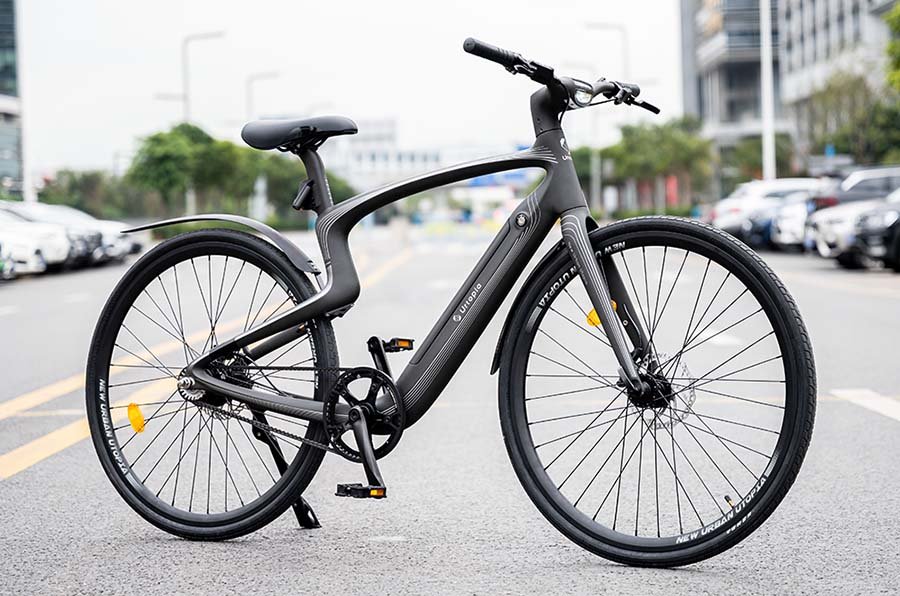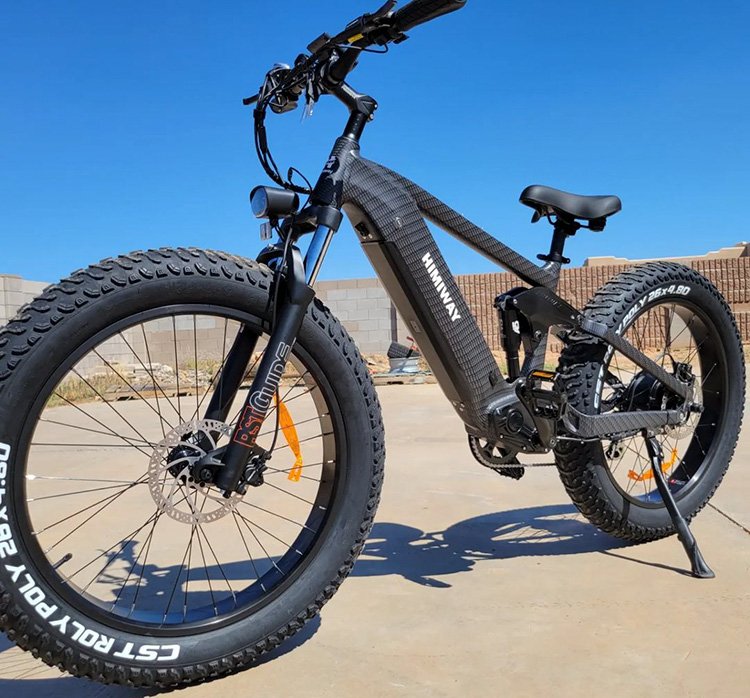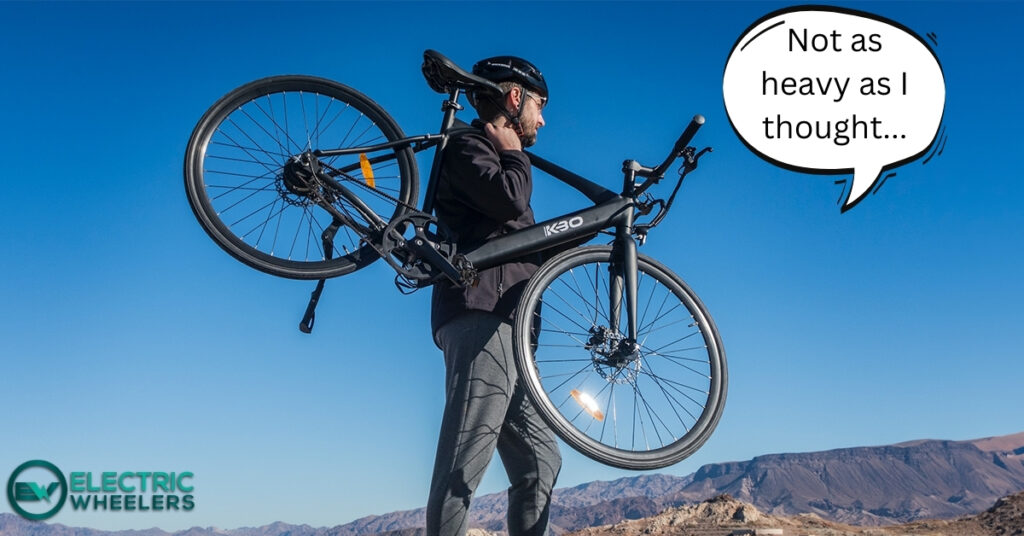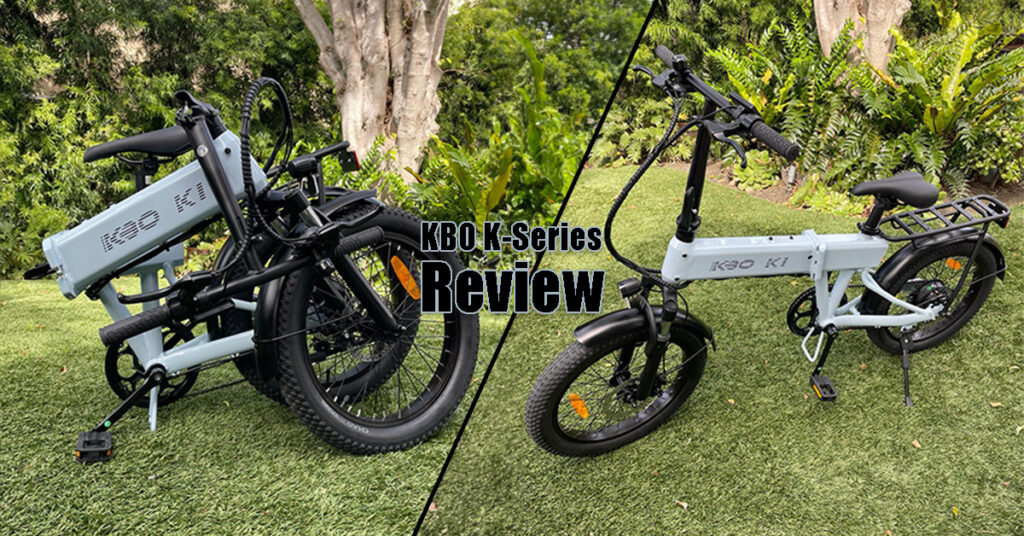Weight is a crucial factor to consider before purchasing an electric bike. This is because the precise weight can alter or improve your riding experience.
We have compared hundreds of e-bikes from different e-bike brands, so we know how much they weigh.
The average weight of an electric bike can be around 50 to 70 pounds (23-33 kg). But some lightweight models can weigh 30 pounds (14 kg), while others as much as 90 pounds (41 kg) or more.
Continue reading this guide for more information about e-bike weights and how they can affect your riding experience.
Are Electric Bikes Heavier than Regular Bikes?
Mostly, e-bikes are heavier than regular bikes because of the added weight of the battery and motor. Nonetheless, the difference in weight can vary depending on the specific e-bike and regular bike model in comparison.
On average, an e-bike can weigh about 5-30 pounds more than a regular bike, depending on the type and model. For instance, a typical lightweight road bike can weigh about 15-25 pounds (7-11 kg), while a smaller e-bike can weigh between 30-80 pounds (14-36 kg). Ebikes with fat tires and lots of accessories weigh more of course.
But it’s worth noting that there are different variations in the weight of both regular and electric bikes, depending on the components, materials, and features used during manufacture.
Different types of E-Bikes Have a Different Weight
Additionally, high-end bikes use more lightweight and durable materials than entry-level models. So, the overall weight varies significantly.
Next, let’s take a look at the weight of different types of e-bikes.
Commuter Electric Bikes are Rather Lightweight
Commuter electric bikes can be relatively light. However, the weight can vary depending on the specific model, frame size, or the number of components installed.
But on average, a commuter e-bike can weigh about 30 to 80 pounds (14-36 kg).

Some models, like the 16 kg Ampler Axel commuter e-bike, Aventon Soltera, and Ride1Up Roadster look like regular bikes but are actually electric urban e-bikes.
Other commuter bikes with fat tires and big motors, like the Ride1up 700 series, Aventon Pace 500, Radrover 6, and Himiway commuter bikes, are much heavier than you would expect.
E-Mountain Bikes are Heavier
Generally, most electric mountain bikes are heavier than traditional mountain bikes. On average, a standard e-mountain bike can weigh about 45 to 60 pounds (20-27 kg), depending on its frame size, battery capacity, and motor power.

On the contrary, some e-bike brands can weigh more or less, depending on their design and frame material. A good example is the Himiway Cobra (heavier than many other electric mountain bikes).
The most common materials on electric mountain bikes include steel, aluminum, titanium, carbon fiber, and magnesium. All these materials have different masses that determine the weight of the bike.
Electric Folding Bikes – not so lightweight as I thought
Electric folding bikes are easy to transport, and store but not so lightweight. Generally, standard e-folding bikes weigh between 60 and 70 pounds (25-32 kg). However, some models are a bit heavier and some are lighter.
But the exact weight depends on the bike’s brand, material, size of the motor, and battery.
E-Cargo Bikes Weigh the Most
Compared to a traditional bike, e-cargo bikes have a longer wheelbase, a sturdy frame, and a larger cargo area.
Most standard models are heavier than ordinary bikes because they have powerful motors, larger batteries, and specialized cargo racks/baskets/trailers.

A few good examples of ultimate e-cargo bikes include the Rad Power Bikes RadWagon 4 and Aventon Abound which have a maximum load capacity of 350 pounds (159 kg) and 330 pounds (150 kg), respectively.
On average, an e-cargo bike weighs between 60 to 100 pounds (27-45 kg), depending on its size and maximum load capacity. Even so, some models have extra components and accessories that make them even heavier.
All-Terrain Bikes Weigh Over 50 Pounds
On average, an electric all-terrain bike weighs between 50 and 70 pounds (23-32 kg).
However, some models can be less, while others like Rambo electric bikes, QuietKat all-terrain adventure bikes, and Bakcou e-bikes weigh more than 70 pounds (32 kg).
Read also: Do Electric Bikes Have a Weight Limit?
Why are e-Bikes So Heavy?
E-bikes have electric motors and batteries, which add significant weight. Also, they sometimes have heavier frames and extra components to support the motor’s weight.
However, the weight of an e-bike is a trade-off for the added convenience and performance benefits of the electric motor and battery.
The Weight of an E-Bike Battery
The weight of an e-bike battery varies depending on a few factors like capacity, size, and technology (chemistry) used.
Generally, a standard less powerful e-bike battery can weigh between 3-7 pounds (1.4-3.2 kg), while larger and higher capacity batteries weigh up to 12 pounds (5.4 kg) or more.

The 36V 10Ah lithium-ion battery is one ordinary battery used in electric bikes. It weighs around 5-6 pounds (2.3-2.7 kg), with higher capacity batteries like the 48V 20Ah battery weighing up to 10 pounds (4.5 kg).
The Weight of an E-Bike Motor
Just like a battery, the weight of an e-bike motor also varies depending on its size, type, power output, and design.
But generally, most motors weigh between 3 to 10 pounds (1.4-4.5 kg), with larger and higher-powered motors being heavier.
But you should also note that hub motors are heavier than mid-drive motors. So, they can weigh between 4 and 8 pounds (2-4 kg), while an average mid-drive motor can weigh between 3 and 6 pounds (1.4-3 kg).

Will e-Bikes Get Lighter in the Future?
Yes. There is a high possibility of e-bikes becoming lighter because the technology and materials used to make them are advancing drastically. A few crucial factors in the weight of e-bikes are battery technology, frame material and manufacturing techniques, and motor power.
Today, e-bike manufacturers produce e-bikes with lightweight frame materials like carbon fiber, magnesium, titanium, and other composite materials. Therefore, there could be advancements to reduce the bike’s weight without compromising the ride quality.
Also, the advancements in Lithium-ion battery and motor design contribute to reducing the bike’s weight because they are becoming lighter and more compact without affecting performance or durability.
Motors, on the other hand, are also becoming more efficient and lightweight, reducing the weight of the electric bike.
Ultimately, there is no guarantee that e-bikes will get lighter, even with the noted progress in bike development. Instead, it is likely that there will be continued advancement in e-bike technology.
Is the Extra Weight Really a Disadvantage of E-Bikes?
According to observation, the extra weight on an electric bike can be an advantage and disadvantage.
For example, heavier bikes can be more difficult to transport or store, while the added weight can provide more stability and control on hilly terrain or windy conditions. The motor also provides assistance to a rider on challenging terrain.
Ultimately, the ideal weight of an electric bike will depend on how you plan to use it, where you live, where you store it, and other personal comfort needs.
Final Words
It’s important to remember that the weight of an electric bike can affect its performance or maneuverability, especially when navigating rough or challenging terrain.
A lighter e-bike can be easy to handle or transport but might lack enough power and battery life. A heavier e-bike can provide more stability and comfort but is challenging to handle or transport.
Choose the electric bike depending on your personal preference and needs.
A freelance writer and copywriter.




